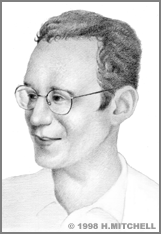Chuck Hoberman
Chuck Hoberman is all at once an inventor, artist, engineer, and architect, whose expandable, collapsible structures are both practical and pleasing to the eye.
Hoberman inherited his interests from his mother, a children’s book author, and his father, an architect. He always wanted to become an artist, and he capped a childhood of drawing and painting by enrolling in art school at Cooper Union in New York City.
One of Hoberman’s instructors assigned the class the task of creating a sculpture that moved. Hoberman met the challenge by creating a piece with sheets of colored plastic that unrolled across the floor. Hoberman was so intrigued by the mechanics of kinetic sculpture that, after he earned his BFA in Sculpture from Cooper Union (1979), he went on to earn a master’s degree in Mechanical Engineering.
Hoberman then went to work for a robotic systems firm, where he added computer modeling (CAD-CAM) skills to his repertoire, but he found his artistic impulses frustrated. After six years, he left to pursue a personal interest that he had developed: the design of devices that transform themselves by expanding and contracting.
Beginning with origami-like paper models that changed shape as they unfolded, Hoberman moved on to metal devices with pivoting members, resembling slightly bowed or bent girders interlaced in crescent or hexagonal shapes, which allowed the devices to balloon outward to a surprising extent. Over the years, Hoberman has continually refined the mechanics of his devices, earning six patents for folding and linkage systems. He also found many practical applications for his devices, which he now produces at Hoberman Associates, the company that he founded in 1990.
A basic Hoberman invention is the Hoberman Sphere™, a geodesic globe that can expand from four and half to eighteen feet in diameter. More impressive still is his Iris Dome, a retractible roofing system of trusses covered with fabric whose “eye” can be opened or closed to the desired diameter. Hoberman’s architectural structures have great strength and stability at any size, because the various members support each other even as they transfer motion uniformly among themselves.
On a smaller scale, Hoberman has used his folding systems to create a collapsible tent made from a single sheet of fabric and a briefcase that collapses, accordian-like, to the size of a shoebox, as well as a number of toys. Without exception, Hoberman’s devices are aesthetically pleasing. They have been exhibited in New York’s Museum of Modern Art (1990), Paris’ Centre Georges Pompidou (1997), and Los Angeles’ California Museum of Science and Industry (1997).
Chuck Hoberman is one of many distinguished inventor-artists working in the U.S. today. Like Arthur Ganson, he creates intricate, kinetic sculpture; like Patricia Billings, he has adapted his sculpture to architectural use. At the same time, the mechanics of Hoberman’s structures are reminiscent of the work of engineers like Nathan Kane, in their inventive use of folds, and Toyoichi Tanaka, in their expanding and contracting. Whether taken as technology or art, toys or architecture, Chuck Hoberman’s unfolding structures are undoubtedly impressive inventions.


